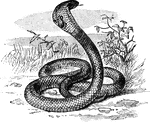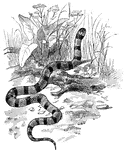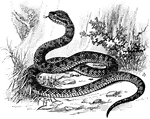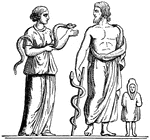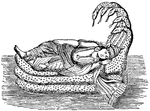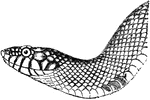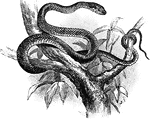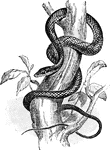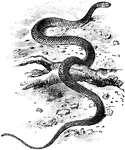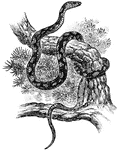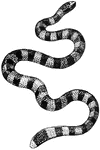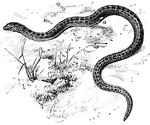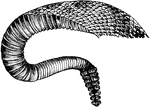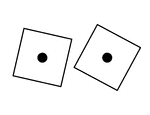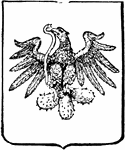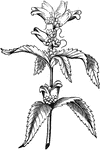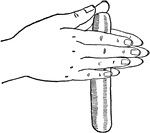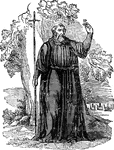
St. Patrick
"St. Patrick appears to have been a native of Boulogne, in France, and to have been born about the year…

Copperhead
A snake of rather small size, usualy under two feet and of a dull pale chestnut or hazel color with…
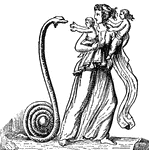
Leto or Latona
"The persecution which Latona experienced from Juno is alluded to in the story. The tradition was that…

Triptolemus
"After his return Triptolemus built a magnificent temple to Ceres in Eleusis and established the worship…
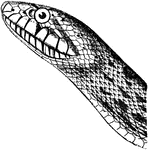
Pine Snake
A very large snake native to North America. It is known to reach lengths of up to twelve feet.

Hog Nosed Snake
A dweller in high, dry upland fields, where the soil is so slightly compacted that burrowing is easy,…
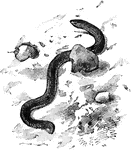
Dart Snake
A book name of the serpent like lizards of the genus Acontias, translating the generic term: so called…

Tree Asp
The narrow ended dendroaspis, otherwise known as the tree asp, tree snake, or mamba. It is about 6 feet…

Boa
"In popular language, the name of all those large serpents which kill their prey by entwining themselves…

Hygieia
"In the classical mythology, the goddess of Health- the daughter of Aesculapius. She was worshipped…
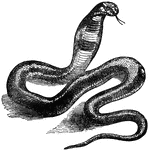
Asp
"A venomous serpent, the name of which has come down from ancient times; the vague descriptions of ancient…
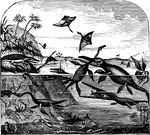
Reptiles
In this age the animals and plants begin to resemble existing species. The age is characterized mainly…

War Token, 1865
War token with union shield and "ONE COUNTRY" obverse and snake and "BEWARE" reverse. These little mementoes…

Mosasaurus Jaw
The jaw bones of the Mosasaurus, a great snake-like reptile of the Cretaceous Period.

Boa Constrictor Skull
"Skull of Boa constrictor. a, quadrate bone; b, b, halves of lower jaw." -Cooper, 1887

Snake Head
"Snake's head. dv., Poison fangs; b., sheath of fang; l., tongue; rl., muscles of tongue." -Thomson,…
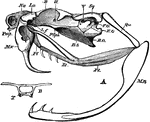
Rattlesnake Skull
"A, lateral view of skull of rattlesnake (Crotalus). B. O, basi-occipital; B. S, basi-sphenoid; E. O,…

Rattlesnake Poison Apparatus
"Poison apparatus of rattlesnake. A, eye; Gc, poison-duct entering the poison-fang at +; Km, muscles…
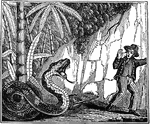
Escape from the Serpent of Ceylon
Miraculous escape from the royal serpent of Ceylon. Caption bellow illustration: "In dreadful anticipation…
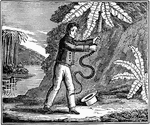
Conflict with a Rattlesnake
Conflict with a rattlesnake. Caption below illustration: "The snake when about a yard distant, made…
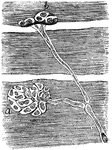
Muscular Fiber Cells of a Snake
From preparation of the nerve termination in the muscular fibers of a snake. A, End plate seen only…

The Tiger-Snake
"The most vicious as well as the most dangerous snake in Australia is the Tiger-snake."

Ringed Snake
"They are easily tamed, and may be kept in houses, where they soon accustom themselves to those who…
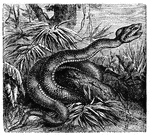
Fer-de-Lance
"The Viperine Snakes have a long, perforated, erectile fang on the maxillary bone, which is extremely…
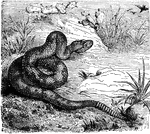
Northern Rattlesnake
"Although furnished with such deadly weapons, the rattlesnake can scarcely be termed a vicious animal,…

Fangs and Tongue of an Adder
"When the animal wishes to use these teeth, they issue from this fleshy sheath, somewhat in the same…

Sharp-Nosed Eel
The sharp-nosed eel (Anguilla acutirostris) is a is also known as the European eel (Anguilla anguilla).

Emerald Tree Boa
Xiphosoma Caninum or Corallus caninus is a non-venomous boa species found in the rainforests of South…
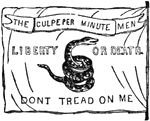
The Culpepper Flag
The Culpeper Minutemen chose the coiled snake ready to strike and the words from Gadsden's flag, but…
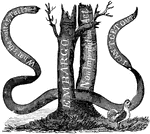
Non Importation Act
Newspapers and speakers especially condemned the "land embargo" — the cutting-off trade with Canada.…

A Union Device
"Unite or Die." This snake device first appeared when the Stamp Act excitement was at its height.

Cobra Head
Cobras are venomous snakes of the familys Elapidae, of several genera, but particularly Naja. (Non-cobra…
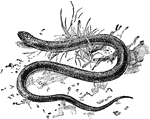
Scheltopusik
The scheltopusik or European legless lizard (Ophisaurus apodus) belongs to the genus of glass lizards:…

Dipsa
Dipsa is a tiny, extremely poisonous snake from Medieval bestiaries. They were said to be said to be…
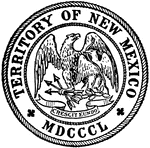
Seal of New Mexico
The Great Seal of the State of New Mexico, 1850. The seal pictures the American Bald Eagle and the Mexican…
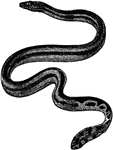
Sea Snake
The Sea Snake (Pelamis bicolor) is a tropical sea snake known for its black color on top and yellow…
